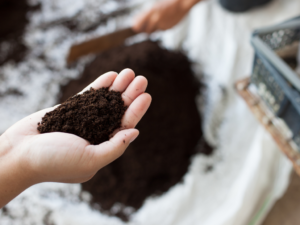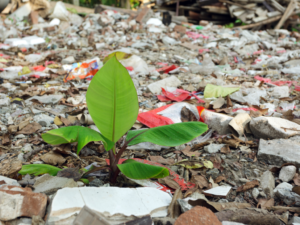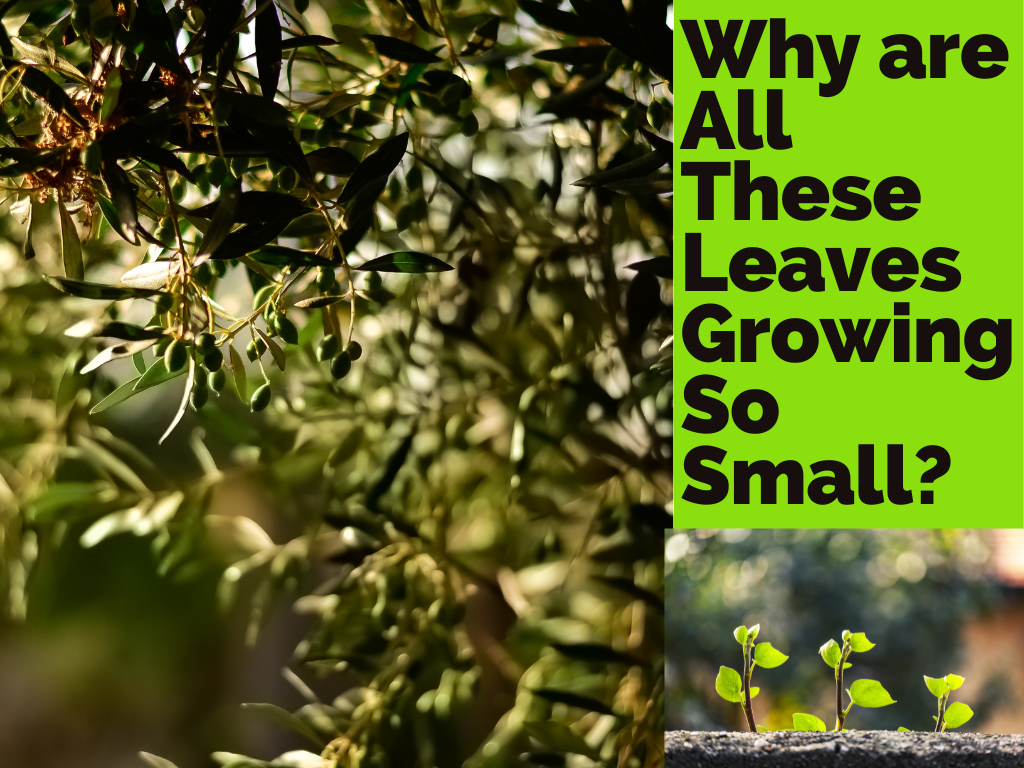Leaves growing so small could be an alarming condition if not cured on time. Leaves come in all shapes and sizes. Some are small and delicate, while others are large and tough. Some are simple and smooth, while others are complex and lobed.
In the past few years, leaves have been growing smaller and scientists aren’t quite sure why. Some say it’s because of climate change, while others claim it’s due to pests and diseases. This is especially true of tree leaves, which have shrunk by an average of 10 percent since the 1980s. But why? There are a few possible explanations.
Why are All These Leaves Growing So Small?
As the leaves on trees and shrubs grow, they expand in size. However, if the leaves are smaller than they should be for the species, it can be a sign that something is wrong. There are many potential causes for small leaves, including temperature, humidity, sunlight, fertilizers, water, CO2, and nutrient imbalances. While some of these causes are easy to fix, others may require more effort.
There are several other potential explanations for why leaves may be shrinking, including changes in salt, climate, pH, pests, diseases, rainfall, and soil quality. Here you can read each of the reasons in detail. Let’s get started.
1. The Effect of Insufficient Light on Making Leaves Smaller

When it comes to the size of leaves, light plays a big role. If a plant isn’t getting enough light, its leaves will be smaller than they should be. This is because the plant is trying to conserve energy by not putting out too much foliage.
Not only are the leaves smaller, but they’re also often different shapes than they would be if the plant was getting enough light. Also, the plant may produce smaller leaves overall as it tries to conserve energy.
If you think your plants aren’t getting enough light, move them to a brighter spot or add some artificial lighting. With more light, they’ll produce bigger and healthier leaves.
2. The Effect of Temperature Imbalance on Making Leaves Smaller
A new study has found that temperature imbalances can have a significant effect on the size of leaves. The research, which was conducted at the University of Tokyo, looked at the effects of both high and low temperatures on the growth of leaves. The findings showed that when temperature conditions are not ideal, leaves tend to be smaller. This is because plants are not able to photosynthesize as efficiently in these conditions. This can have a serious impact on the health of plants as well as the ecosystems they are a part of. The research highlights the importance of maintaining stable temperatures for plant growth and health.
3. The Effect of Humidity Imbalance on Making Leaves Smaller

Leaves are an essential part of a plant, as they perform vital functions such as photosynthesis and transpiration. However, leaves can be affected by various environmental factors, one of which is humidity.
Humidity is the amount of water vapour in the air, and it can fluctuate depending on the weather. If there is too much humidity, it can cause leaves to become smaller. This is because excess water vapour interferes with the process of photosynthesis, which reduces the amount of energy that leaves can produce. Additionally, high humidity levels can also lead to fungal growth on leaves, which can further damage them.
On the other hand, if there is not enough humidity, leaves may also become smaller. This is because plants require water vapour for transpiration, which helps to cool them down and prevent them from drying out.
4. The Effect of Fertilizer Imbalance on Making Leaves Smaller

The effect of fertilizer imbalance on making leaves smaller is a phenomenon that has been widely observed by farmers. It is well known that an imbalance in the use of fertilizers can hurt the growth and development of plants. In particular, an imbalance in the use of nitrogenous fertilizers can lead to the formation of small leaves. This is because nitrogen is an essential element for the photosynthesis process, and when there is an imbalance in its use, the photosynthesis process is disrupted, leading to the formation of smaller leaves.
Causes: Many factors can cause an imbalance in the use of fertilizers, such as incorrect application methods, poorly managed irrigation systems, or simply using too much or too little fertilizer. Whatever the cause, an imbalance in fertilizer use will hurt plant growth and development and should be avoided if possible.
5. The Effect of High or Low Water on Making Leaves Smaller

When it comes to the effect of water on making leaves smaller, there is no clear consensus. Some scientists believe that high or low water can have an impact, while others contend that the amount of water is not a factor.
Those who believe that high or low water can affect leaf size argue that the plant needs a certain amount of water to function properly. If the plant does not have enough water, it will not be able to grow properly and its leaves will be smaller. On the other hand, if the plant has too much water, it will also have difficulty growing and its leaves will be smaller.
Those who do not believe that the amount of water is a factor contend that other factors, such as temperature and light, are more important. They argue that a plant cannot grow properly if it does not have enough light or if the temperature is too cold or hot.
6. The Effect of Soil Quality on Making Leaves Smaller

Soil quality is an important factor in determining the size of leaves on a plant. A study was conducted to investigate the effect of different soil qualities on the size of leaves. The results showed that soil quality had a significant effect on leaf size, with plants grown in poorer-quality soils having smaller leaves. This is likely because poor-quality soils contain fewer nutrients, which results in stunted growth. Therefore, if you want to grow plants with large leaves, it is important to use high-quality soil.
7. The Effect of Salts in Water and Fertilizers on Making Leaves Smaller
Salts are often found in water used for irrigation and fertilizer and can have harmful effects on plants. Salts can make leaves smaller by causing them to lose water more quickly, which can lead to stunted growth. In severe cases, salts can cause leaf death. To avoid these problems, it is important to use water that is low in salt content and to leach excess salt from the soil regularly.
8. The Effect of Rainfall on Making Leaves Smaller

When it rains, the water that falls on leaves can cause them to become smaller. This is because the water makes the leaves softer and more pliable, and as a result, they can be easily bent or broken. Additionally, the rain can wash away nutrients that the leaves need to stay healthy. Over time, this can lead to the leaves becoming smaller and weaker.
9. The Effect of Nutrient Imbalance on Making Leaves Smaller

When leaves are small, it can be a sign that the plant isn’t getting the nutrients it needs. An imbalance of nutrients in the soil can cause leaves to be smaller than they should be. This can happen if there’s not enough nitrogen, phosphorus, or potassium in the soil. It can also happen if the plant is getting too much of one nutrient and not enough of another. Too much or too little water can also cause leaves to be smaller than normal.
If you see that the leaves on your plants are smaller than they should be, you’ll need to figure out what’s causing the problem. Check the soil to see if it needs more or less of any of the three main nutrients. You may also need to adjust how often you’re watering your plants.
10. The Effect of pH Imbalance on Making Leaves Smaller

pH is a major factor in the size of leaves. A pH imbalance can make leaves smaller. This is because pH affects the uptake of nutrients from the soil. When the pH is imbalanced, it can cause problems with nutrient uptake, which in turn can lead to smaller leaves.
11. The Effect of Pests or Diseases on Making Leaves Smaller

Pests and diseases can have a big effect on the size of leaves. If a plant is infected with a virus, for example, the leaves may become smaller. This is because the virus causes the plant to produce less chlorophyll, which is what gives leaves their green colour. Pests and diseases can also cause leaves to become deformed, which can make them appear smaller. In some cases, pests or diseases can cause the production of abnormal amounts of hormones, which can lead to the death of cells and a reduction in leaf size.
12. The Effect of Pollution on Making Leaves Smaller

As the air around us becomes increasingly polluted, we are seeing a corresponding decrease in the size of leaves. Studies have shown that pollution has a direct and negative effect on the size of leaves, making them smaller.
There are several reasons why pollution has this effect on leaves. First, polluted air contains harmful chemicals that can damage plant cells. Second, polluted air is often warmer than clean air, and plants may react to this by reducing the size of their leaves.
The effects of pollution on leaf size are significant because leaves are an important part of the photosynthesis process. Photosynthesis is how plants convert sunlight into energy, and it is essential for plant growth. If leaves are smaller, they are less efficient at photosynthesis, and plant growth may be stunted.
13. The Effect of Climate Change on Making Leaves Smaller

Climate change is having a profound effect on the size of leaves, causing them to shrink in both length and width. This effect is most pronounced in tropical regions, where leaves are already small, to begin with.
Scientists believe that this phenomenon is caused by rising temperatures and changes in precipitation patterns. As the climate continues to warm, leaves will continue to shrink in size. This could have serious implications for the health of plants and the ecosystems they support.
While more research is needed to confirm these findings, it is clear that climate change is already having an impact on the size of leaves around the world. As we continue to feel the effects of climate change, we may need to adapt our gardening and landscaping practices to account for smaller leaves.
The Average Leaf: What is “Normal” and the Effect of CO2
The average leaf size has been steadily decreasing for the past 50 years, and scientists are still trying to determine why. One study found that the primary reason for smaller leaves is due to increases in atmospheric CO2 levels. This causes plants to produce more leaves to absorb more sunlight for photosynthesis. However, these additional leaves are smaller in size than the original leaves.
The Most Important Steps in How to Make Plants’ Leaves Bigger
If you want to make your plant’s leaves bigger, there are a few things you can do. First, try giving them more light. Put them in a spot where they’ll get plenty of sunlight, and make sure to rotate them occasionally so that all sides of the leaves get exposure. Secondly, fertilize them regularly with a good quality fertilizer made specifically for plants. Third, make sure they’re getting enough water. Leaves need moisture to grow, so water them deeply and regularly, especially during the hot summer months. With a little extra care, you can enjoy big, healthy leaves on your plants.
Final Thoughts
The leaves on the trees are getting smaller because of many causes, including temperature, humidity, sunlight, fertilizers, water, salt, climate, pH, pests, diseases, and rain. CO2 levels and nutrient imbalances in the soil could also be contributing factors. To solve this problem, we need to figure out which of these causes is the most significant. Only then can we take the appropriate measures to return the leaves to their normal size.

